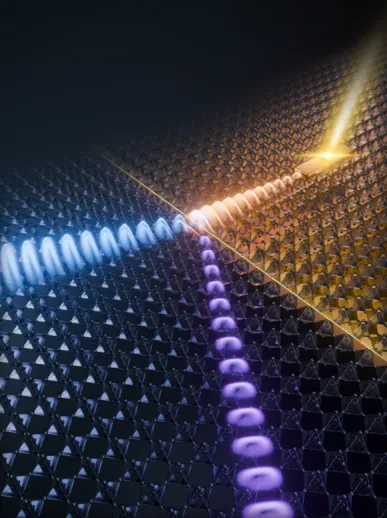Two-step excitation unlocks and steers exotic nanolight
A new two-step excitation technique efficiently generates and separates different modes of hyperbolic polaritons — directional nanoscale light-matter modes with extreme electromagnetic field confinement — opening new opportunities for ultra-compact photonic circuits.

An international team of researchers, including researchers from the NanoOptics group at CIC nanoGUNE, has developed a novel technique to efficiently excite and control highly-confined light-matter waves, known as higher-order hyperbolic phonon polaritons (HPhPs). Their method not only sets new records for the quality and propagation distance of these waves but also uses a sharp boundary to create a form of pseudo-birefringence, sorting and steering the waves by mode into different directions. This breakthrough, published in Nature Photonics, opens new avenues for developing nanoscale optical devices for high-speed signal processing and ultra-sensitive chemical detection. The full study is available at: https://www.nature.com/articles/s41566-025-01755-5
In the quest for ultra-compact, light-based circuits, scientists are turning to polaritons—hybrid modes formed from the coupling of light with optically active material excitations such as plasmons or phonons. These remarkable quasiparticles can squeeze light into spaces far smaller than its natural wavelength, overcoming the conventional limits of far-field optics. However, exciting most confined variants - higher-order polaritons - has been a major challenge, as they demand a much larger momentum boost than single-step excitation methods can deliver.
Led by scientists from Shanghai Jiao Tong University and the National Center for Nanoscience and Technology (China), together with CIC nanoGUNE and ICFO – The Institute of Photonic Sciences (Spain), the team developed an ingenious two-step excitation process. First, a tiny light-illuminated gold antenna provides an initial push, creating a fundamental (zero-order) hyperbolic phonon polariton mode on a smooth biaxial MoO3 crystal slab placed on a single-crystalline gold substrate. This wave then travels to the edge of the gold, where the substrate abruptly ends and the crystal is suspended in air. As it crosses this abrupt boundary, the wave is scattered, transforming into higher-order phonon polaritons.
"Scattering the zero-order polariton at the boundary provides the large momentum boost needed to excite higher-order modes," explains Prof. Rainer Hillenbrand, a lead author of the study. "We found that this two-step method substantially enhances the excitation efficiency compared with traditional single-step excitation techniques."
This enhanced excitation efficiency, combined with an ultra-smooth, low-loss air-suspended MoO3 slab, allowed the team to observe higher-order polaritons of unprecedented quality. The waves achieved a record-high quality factor of ~45 and a long propagation distance, demonstrating potential for next-generation photonic technologies.
A new way to steer nanolight
The most striking result of this new polariton excitation technique is a phenomenon the team calls "pseudo-birefringence." At the sharp gold-air boundary, different polariton modes are spatially separated while preserving their polarization. The fundamental and higher-order modes bend at different angles, causing them to propagate in entirely different directions.
"We have effectively created a traffic controller for light on the nanoscale," says Prof. Qing Dai, another lead author. "This ability to sort different orders of hyperbolic polaritons is a new tool for designing ultra-compact photonic circuits. It is similar to the birefringence effect in certain crystals, but here it occurs without any change in the light's polarization and is more than ten times stronger."
This powerful mode-sorting effect could be harnessed for mode-division multiplexing, a technique that uses different wave shapes to carry multiple independent data streams along a single nanowaveguide, dramatically increasing information-processing capacity. Other potential applications include novel optical filters, waveplates, and highly sensitive on-chip biosensors.
Overall, the work provides a foundational platform for manipulating light at the nanoscale, with far-reaching implications for future nanophotonics, on-chip communication, and information processing technologies.
https://www.nature.com/articles/s41566-025-01755-5
The research was carried out by a collaborative team from Shanghai Jiao Tong University and the National Center for Nanoscience and Technology in China, together with CIC nanoGUNE and ICFO – The Institute of Photonic Sciences in Spain.
Prof. Qing Dai, Shanghai Jiao Tong University, P. R. China, Email: daiqing@sjtu.edu.cn
Prof. Rainer Hillenbrand, CIC nanoGUNE, San Sebastian, Spain, Email: r.hillenbrand@nanogune.eu
Prof. Hai Hu, National Center for Nanoscience and Technology, P. R. China, Email: huh@nanoctr.cn
